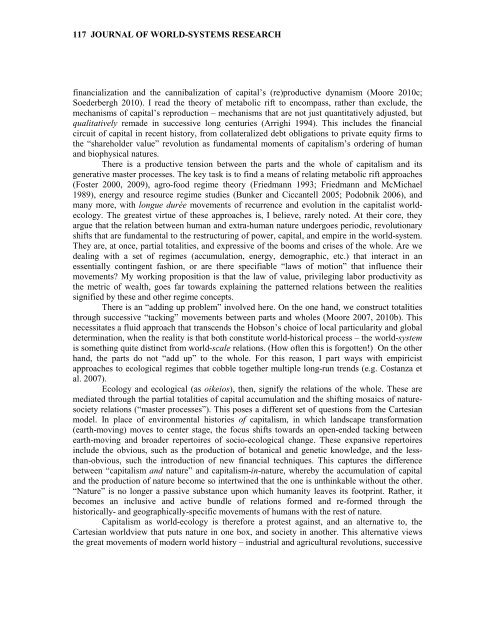Entire Volume 17 issue 1 - Journal of World-Systems Research ...
Entire Volume 17 issue 1 - Journal of World-Systems Research ...
Entire Volume 17 issue 1 - Journal of World-Systems Research ...
You also want an ePaper? Increase the reach of your titles
YUMPU automatically turns print PDFs into web optimized ePapers that Google loves.
1<strong>17</strong> JOURNAL OF WORLD-SYSTEMS RESEARCH<br />
financialization and the cannibalization <strong>of</strong> capital’s (re)productive dynamism (Moore 2010c;<br />
Soederbergh 2010). I read the theory <strong>of</strong> metabolic rift to encompass, rather than exclude, the<br />
mechanisms <strong>of</strong> capital’s reproduction – mechanisms that are not just quantitatively adjusted, but<br />
qualitatively remade in successive long centuries (Arrighi 1994). This includes the financial<br />
circuit <strong>of</strong> capital in recent history, from collateralized debt obligations to private equity firms to<br />
the “shareholder value” revolution as fundamental moments <strong>of</strong> capitalism’s ordering <strong>of</strong> human<br />
and biophysical natures.<br />
There is a productive tension between the parts and the whole <strong>of</strong> capitalism and its<br />
generative master processes. The key task is to find a means <strong>of</strong> relating metabolic rift approaches<br />
(Foster 2000, 2009), agro-food regime theory (Friedmann 1993; Friedmann and McMichael<br />
1989), energy and resource regime studies (Bunker and Ciccantell 2005; Podobnik 2006), and<br />
many more, with longue durée movements <strong>of</strong> recurrence and evolution in the capitalist worldecology.<br />
The greatest virtue <strong>of</strong> these approaches is, I believe, rarely noted. At their core, they<br />
argue that the relation between human and extra-human nature undergoes periodic, revolutionary<br />
shifts that are fundamental to the restructuring <strong>of</strong> power, capital, and empire in the world-system.<br />
They are, at once, partial totalities, and expressive <strong>of</strong> the booms and crises <strong>of</strong> the whole. Are we<br />
dealing with a set <strong>of</strong> regimes (accumulation, energy, demographic, etc.) that interact in an<br />
essentially contingent fashion, or are there specifiable “laws <strong>of</strong> motion” that influence their<br />
movements? My working proposition is that the law <strong>of</strong> value, privileging labor productivity as<br />
the metric <strong>of</strong> wealth, goes far towards explaining the patterned relations between the realities<br />
signified by these and other regime concepts.<br />
There is an “adding up problem” involved here. On the one hand, we construct totalities<br />
through successive “tacking” movements between parts and wholes (Moore 2007, 2010b). This<br />
necessitates a fluid approach that transcends the Hobson’s choice <strong>of</strong> local particularity and global<br />
determination, when the reality is that both constitute world-historical process – the world-system<br />
is something quite distinct from world-scale relations. (How <strong>of</strong>ten this is forgotten!) On the other<br />
hand, the parts do not “add up” to the whole. For this reason, I part ways with empiricist<br />
approaches to ecological regimes that cobble together multiple long-run trends (e.g. Costanza et<br />
al. 2007).<br />
Ecology and ecological (as oikeios), then, signify the relations <strong>of</strong> the whole. These are<br />
mediated through the partial totalities <strong>of</strong> capital accumulation and the shifting mosaics <strong>of</strong> naturesociety<br />
relations (“master processes”). This poses a different set <strong>of</strong> questions from the Cartesian<br />
model. In place <strong>of</strong> environmental histories <strong>of</strong> capitalism, in which landscape transformation<br />
(earth-moving) moves to center stage, the focus shifts towards an open-ended tacking between<br />
earth-moving and broader repertoires <strong>of</strong> socio-ecological change. These expansive repertoires<br />
include the obvious, such as the production <strong>of</strong> botanical and genetic knowledge, and the lessthan-obvious,<br />
such the introduction <strong>of</strong> new financial techniques. This captures the difference<br />
between “capitalism and nature” and capitalism-in-nature, whereby the accumulation <strong>of</strong> capital<br />
and the production <strong>of</strong> nature become so intertwined that the one is unthinkable without the other.<br />
“Nature” is no longer a passive substance upon which humanity leaves its footprint. Rather, it<br />
becomes an inclusive and active bundle <strong>of</strong> relations formed and re-formed through the<br />
historically- and geographically-specific movements <strong>of</strong> humans with the rest <strong>of</strong> nature.<br />
Capitalism as world-ecology is therefore a protest against, and an alternative to, the<br />
Cartesian worldview that puts nature in one box, and society in another. This alternative views<br />
the great movements <strong>of</strong> modern world history – industrial and agricultural revolutions, successive





